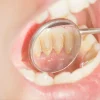Get information about Braces treatment with the explanation of expert dentist Merve Özkan Akagündüz.
Braces Treatment

Braces Treatment, Doredent İstanbul
Dental braces treatment is an orthodontic treatment method aimed at improving a person's oral health and aesthetics by correcting the position of teeth, jaws, and bite relationships. There is no age limit for getting dental braces treatment. Nowadays, it has become a commonly applied treatment method by adult individuals as well.
In dental braces treatment, rectangular pieces called brackets are bonded to the surface of the teeth and remain fixed throughout the treatment duration. Arch wires are attached to the brackets using either metal or elastic ligatures. The teeth bonded with brackets move to try to accommodate the shape of the arch wire, and the process continues with various tooth movements until the desired final outcome is achieved. This is the basic mechanism of treatment.
When dental braces treatment is mentioned, metal brackets and wires often come to mind, but in fact, ceramic (porcelain) brackets and aesthetic arch wires also fall within this treatment scope. The use of ceramic brackets and wires allows avoiding a metallic appearance. Ceramic brackets offer a nice alternative for individuals who approach orthodontic treatments with prejudice.
Among orthodontic treatments, lingual treatments, which involve placing brackets on the tongue side of the tooth surface, are considered the most aesthetic. Since no treatment is done on the outer surface of the tooth, lingual braces are invisible from the outside. Every movement is performed by the lingual brackets. Unless the individual mentions undergoing treatment, it is not possible for their social circle to notice. The only noticeable change is the gradual improvement in the alignment of the teeth over time.
Orthodontic treatments involve movements of the teeth based on their ability to move. Tooth movement involves bone resorption in the direction of tooth movement and bone deposition in the opposite direction. Therefore, the amount, type, and duration of force applied to the teeth for movement are crucial. The force applied should be sufficient to move the tooth but not enough to cause damage. Striking this balance is highly important; otherwise, it can lead to situations resulting in tooth loss.
During treatments performed by orthodontic specialists, forces close to physiological forces are applied to the teeth; hence, the movements of the teeth occur slowly. Therefore, orthodontic treatments take a long time. The total treatment duration varies due to many factors, but generally, it can be said to be an average of 1-2 years.
When Can Dental Braces Treatment Start?
Dental braces treatments generally begin around the ages of 11-13 when all permanent teeth have erupted. If there is a likelihood of teeth being impacted, if rapid correction of malocclusion is believed to contribute to jaw relationships, or if there is another specific situation, it may be necessary to start orthodontic treatments at an earlier age. However, the decision can only be made based on clinical and radiological examinations by an orthodontic specialist.
Early diagnosis and intervention or correction of orthodontic problems at the earliest possible time are ideal for treatment success. Therefore, it is advisable for children to visit a dentist or an orthodontic specialist every six months starting from the age of 6.
How Is Dental Braces Treatment Applied?
First, the patient is evaluated clinically and radiologically. Then, a personalized treatment plan is prepared. Prior to treatment, procedures such as scaling and filling are completed, and an appointment for brace placement is scheduled for the patient.
Before dental braces treatment, intraoral and extraoral photographs of the patient are taken, and the bracketing process, where brackets are bonded to the tooth surface, is carried out. Once bracketing is completed, thin wires called arch wires are attached to the brackets using elastic or metal components. Typically, bracketing for a single jaw is done in a single session to minimize the duration the mouth remains open during the procedure and to facilitate the patient’s adaptation to treatment.
After the braces are applied, the patient regularly attends control appointments. At these appointments, procedures such as wire changes and wire tightening are performed to guide tooth movements. The patient must attend monthly check-ups for the progress of orthodontic treatment.
Once the teeth are brought to their desired positions, the wires are removed. A thin wire called a retainer is bonded to the back of the front teeth. If necessary, passive clear aligners (essix) are applied to both jaws. These applications are made to ensure the permanence of orthodontic treatment.
After the wires are removed, the process of applying retainers or essix aligners and monitoring the patient is called the retention phase. It is as important a process as the active wire treatment phase. The importance given to the retention process determines the patient’s ability to maintain a proper smile throughout their lifetime.
You can use our Dental Braces Price Calculator tool to inquire about the prices of dental braces treatments. Our price calculator is designed to give you an idea about treatment costs. However, final treatment prices can only be provided after a dentist’s examination.
Metal Brackets
Metal brackets are the type of orthodontic components made of metal that are bonded to the surface of teeth to facilitate orthodontic treatment. They have been used for many years and are still among the most commonly preferred materials today. Treatments begin by bonding the brackets to the tooth surface, followed by attaching thin arch wires to the brackets with small ligatures. These small ligatures can be made of metal or elastic material. Elastic ligatures come in various colors, which can serve as an accessory and a source of motivation for individuals who want to add some color to their orthodontic treatment.
Metal brackets are highly durable and offer a more economical option compared to other types. They can be used for all types of orthodontic problems and yield successful treatment results. The friction force between the arch wires and metal brackets is lower compared to porcelain brackets, allowing for a faster treatment process. At the end of the treatment, they can be easily removed from the tooth surface in one piece. For individuals with a nickel allergy, there are nickel-free options available.
The main disadvantage of metal brackets is their noticeable appearance on the tooth surface. Since orthodontic treatments are relatively long, this can be bothersome for individuals who are uncomfortable with the metal appearance.
Porcelain (Ceramic) Brackets
For individuals who are bothered by the appearance of metal brackets, porcelain brackets offer a good alternative. These brackets are made of porcelain-based material and appear almost the same color as natural teeth, making them less noticeable. This is why they have become popular in recent years among individuals with aesthetic concerns who need orthodontic treatment.
All cases that can be treated with metal brackets can also be treated with porcelain brackets. Their treatment mechanisms are the same. Apart from the difference in appearance and cost, there is no significant difference between them.
Since porcelain materials are more expensive than metals, this increases the cost of treatment. Thus, treatments with porcelain brackets are more expensive compared to those with metal brackets.
Self-Ligating Brackets
Self-ligating brackets are a type of bracket with a built-in locking mechanism that does not require additional ligatures to connect the arch wire to the bracket. The presence of a self-ligating mechanism reduces friction between the arch wire and the bracket, allowing for faster tooth movements. Consequently, the overall treatment time is shortened.
Since self-ligating brackets do not require separate ligatures, the occurrence of mouth sores is less frequent. Some special types of self-ligating brackets allow the teeth to be arranged in a wider arch form, providing the possibility of non-extraction treatment in borderline cases where extraction might otherwise be necessary.
Self-ligating brackets are generally made of metal. There are also porcelain self-ligating bracket options where the locking mechanism is metal.
Clear Aligners
In recent years, clear aligner treatments have undoubtedly become the most popular orthodontic treatment method. A series of aligners are produced for the treatment, and teeth are gradually moved by using these aligners sequentially. The daily usage time for aligners is 20-22 hours. The effectiveness of tooth movements depends on the regular use of the aligners.
Clear aligners are almost invisible, thin, and delicate trays. They can be easily taken in and out. Since they are removed during eating, there are no dietary restrictions. Teeth can be brushed as usual without any inconvenience.
Merve Özkan Akagündüz
I was born in Edirne in 1988. In 2007, I began my master’s degree in Dentistry at Istanbul University (Çapa) Faculty of Dentistry and graduated in 2012.
In 2014, I started my specialization in the Department of Orthodontics at Süleyman Demirel University Faculty of Dentistry. In 2019, I earned the title of Orthodontist and was appointed to Çorlu ADSM, where I worked as an Orthodontic Specialist Dentist from 2019 to 2022.
As of 2024, I have been continuing my practice in my own clinic.








